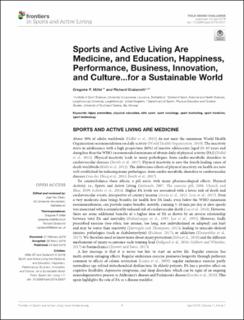Sports and Active Living Are Medicine, and Education, Happiness, Performance, Business, Innovation, and Culture…for a Sustainable World
Peer reviewed, Journal article
Published version
Permanent lenke
https://hdl.handle.net/11250/2646966Utgivelsesdato
2019Metadata
Vis full innførselSamlinger
Sammendrag
About 30% of adults worldwide (Hallal et al., 2012) do not meet the minimum World Health Organization recommendation on daily activity (World Health Organization, 2010). The inactivity starts in adolescence with a high proportion (80%) of inactive adolescents [aged 13–15 years and doing less than the WHO-recommended minimum of 60 min daily of physical activity (PA)] (Hallal et al., 2012). Physical inactivity leads to many pathologies, from cardio-metabolic disorders to cardiovascular diseases (Booth et al., 2017). Physical inactivity is now the fourth leading cause of death worldwide (Kohl et al., 2012). The deleterious effects of physical inactivity on health are now well-established for inducing many pathologies, from cardio-metabolic disorders to cardiovascular diseases (van der Ploeg et al., 2012; Booth et al., 2017).
To counterbalance these effects, a pill exists with many pharmacological effects: Physical Activity; i.e., Sports and Active Living (Imbeault, 2007; The exercise pill, 2008; Church and Blair, 2009; Lobelo et al., 2014). Higher PA levels are associated with a lower risk of death and cardiovascular events, irrespective of country income (Arem et al., 2015; Lear et al., 2017). Even a very moderate dose brings benefits for health: low PA loads, even below the WHO minimum recommendations, can provide major benefits; notably, running 5–10 min per day at slow speeds was associated with a considerably reduced risk of cardiovascular death (Lee et al., 2014). However, there are some additional benefits of a higher dose of PA as shown by an inverse relationship between total PA and mortality (Paffenbarger et al., 1993; Lee et al., 1995). However, badly prescribed exercise (too often, too intense, too long, not individualized or adapted) can hurt and may be worse than inactivity (Eijsvogels and Thompson, 2015), leading to musculo-skeletal injuries, pathologies (such as rhabdomyolysis) (Eichner, 2017), or addiction (Hausenblas et al., 2017). We therefore need to know more about injury prevention (Silva et al., 2018) and the different mechanisms of injury occurrence such training load (Soligard et al., 2016; Gabbett and Whiteley, 2017) or biomechanics (Hewett and Bates, 2017).
A key message is that it is never too late to start an active life. Regular exercise has multi-system antiaging effects. Regular endurance exercise promotes longevity through pathways common to effects of caloric restriction (Lanza et al., 2008): regular endurance exercise partly normalizes age-related mitochondrial dysfunction. In elderly patients, PA has a positive effect on cognitive flexibility, depressive symptoms, and sleep disorders, which can be signs of an ongoing neurodegenerative process as Alzheimer's disease and Parkinson's disease (Lerche et al., 2018). This again highlights the role of PA as a disease modifier.

